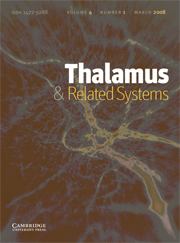Article contents
Thalamus in flame: targeting of infectious agents to thalamic nuclei
Published online by Cambridge University Press: 18 April 2006
Abstract
The involvement of the thalamus in infectious diseases of the nervous system has been hitherto rather neglected by investigators in clinical and basic neuroscience, despite numerous reports indicating that the thalamus, and territories within this region, can be attacked by different types of microbes. This topic is here reviewed. First, an overview is provided on general principles of spread of microbes to the brain (through peripheral nerves, or through the blood or cerebrospinal fluid) and their interactions with neurons and immune cells to cause acute, transient or persistent infections. Examples are given on how non-cytolytic infections can cause long-lasting disturbances in synaptic activities and neuronal networks as a result of a “hit-and-run” mechanism, or as an effect of factors released in the microenvironment to control the neuronal infection. Emerging data on how molecules functioning at the “immunological synapse” (the site of contact between immune cells and target infected cells) may affect nervous system synapses are pointed out. An account is then given of clinical and experimental infections of the thalamus caused by viruses (rabies and herpes viruses, influenza A virus, flaviviruses, HIV virus), the parasite Toxoplasma gondii, and prions. The implications and consequences of the attack of these microbes to the thalamus are discussed. Of special interest is the potential persistence of latent infections in thalamic neurons, which could cause disturbances of neuronal functions in the absence of overt structural lesions. Altogether these data recall attention on the pathogenesis and consequences of acute and persistent infections in the mammalian thalamus.
Keywords
Information
- Type
- Research Article
- Information
- Copyright
- 2004 Elsevier Science Ltd
- 2
- Cited by

